Applied Mechanics of Solids
Allan F. Bower
�
Applied Mechanics of Solids
Allan F. Bower
This electronic text summarizes the physical laws, mathematical methods, and computer
algorithms that are used to predict the response of materials and structures to mechanical or
thermal loading.
Topics include: the mathematical descriptions of deformation and forces in solids; constitutive
laws; analytical techniques and solutions to linear elastic and elastic-plastic boundary value
problems; the use and theory of finite element analysis; fracture mechanics; and the theory of
deformable rods, plates and shells.
Over 400 practice problems are provided, as well as demonstration finite element codes in
MAPLE and MATLAB.
The text is intended for advanced undergraduate or graduate students, as well as practicing
engineers and scientists. It will be particularly useful to readers who wish to learn enough about
solid mechanics to impress their teachers, colleagues, research advisors, or managers, but who
would prefer not to study the subject in depth.
About the author
The author received undergraduate and graduate degrees from the University of Cambridge. He is
currently Professor of Engineering at Brown University.
Professor Bower learned solid mechanics by eavesdropping on the conversations of his colleagues,
who are all famous experts in the field.
1
�
Table of Contents
1.1 Defining a Problem in Solid Mechanics
1.1.1 Deciding what to calculate
1.1.2 Defining the geometry of the solid
1.1.3 Defining loading
1.1.4 Deciding what physics to include in the model
1.1.5 Defining material behavior
1.1.6 A representative initial value problem in solid mechanics
1.1.7 Choosing a method of analysis
1. Objectives and Applications of Solid Mechanics
2. Governing Equations
2.1 Mathematical Description of Shape Changes in Solids
2.1.1 The displacement and velocity fields
2.1.2 The displacement gradient and deformation gradient tensors
2.1.3 Deformation gradient resulting from two successive deformations
2.1.4 The Jacobian of the deformation gradient
2.1.5 The Lagrange strain tensor
2.1.6 The Eulerian strain tensor
2.1.7 The infinitesimal strain tensor
2.1.8 Engineering shear strains
2.1.9 Decomposition of infinitesimal strain into volumetric and deviatoric parts
2.1.10 The infinitesimal rotation tensor
2.1.11 Principal values and directions of the infinitesimal strain tensor
2.1.12 Cauchy-Green deformation tensors
2.1.13 Rotation tensor, Left and Right stretch tensors
2.1.14 Principal stretches
2.1.15 Generalized strain measures
2.1.16 The velocity gradient
2.1.17 Stretch rate and spin tensors
2.1.18 Infinitesimal strain rate and rotation rate
2.1.19 Other deformation rate measures
2.1.20 Strain equations of compatibility for infinitesimal strains
2.2 Mathematical Description of Internal Forces in Solids
2.2.1 Surface traction and body force
2.2.2 Traction acting on planes within a solid
2.2.3 The Cauchy (true) stress tensor
2.2.4 Other stress measures - Kirchhoff, Nominal and Material stress
2.2.5 Stress measures for infinitesimal deformations
2.2.6 Principal stresses and directions
2
�
2.2.7 Hydrostatic stress, Deviatoric stress, and Von Mises effective stress
2.2.8 Stresses near an external surface or edge – boundary conditions
2.3 Equations of motion and equilibrium for deformable solids
2.3.1 Linear momentum balance in terms of Cauchy stress
2.3.2 Angular momentum balance in terms of Cauchy stress
2.3.3 Equations of motion in terms of other stress measures
2.4 Work done by stresses; Principle of Virtual Work
2.4.1 Work done by Cauchy stresses
2.4.2 Rate of mechanical work in terms of other stress measures
2.4.3 Rate of mechanical work for infinitesimal deformations
2.4.4 The principle of Virtual Work
2.4.5 The Virtual Work equation in terms of other stress measures
2.4.6 The Virtual Work equation for infinitesimal deformations
3. Constitutive Equations: Relations between Stress and Strain
but large rotations
subjected to large strains
3.1 General Requirements for Constitutive Equations
3.2 Linear Elastic Material Behavior
3.2.1 Isotropic, linear elastic material behavior
3.2.2 Stress—strain relations for isotropic, linear elastic materials
3.2.3 Reduced stress-strain equations for plane deformation of isotropic solids
3.2.4 Representative values for density, and elastic constants of isotropic solids
3.2.5 Other elastic constants – bulk, shear and Lame modulus
3.2.6 Physical Interpretation of the elastic constants for isotropic materials
3.2.7 Strain energy density for isotropic solids
3.2.8 Stress-strain relation for a general anisotropic linear elastic material
3.2.9 Physical Interpretation of the anisotropic elastic constants.
3.2.10 Strain energy density for anisotropic, linear elastic solids
3.2.11 Basis change formulas for the anisotropic elastic constants
3.2.12 The effect of material symmetry on anisotropic stress-strain relations
3.2.13 Stress-strain relations for linear elastic orthotropic materials
3.2.14 Stress-strain relations for linear elastic transversely isotropic material
3.2.15 Values for elastic constants of transversely isotropic crystals
3.2.16 Linear elastic stress-strain relations for cubic materials
3.2.17 Representative values for elastic properties of cubic crystals
3.3 Hypoelasticity - elasticity with nonlinear stress-strain behavior
3.4 Generalized Hooke’s law – elastic materials subjected to small stretches
3.5.1 Deformation measures used in finite elasticity
3.5.2 Stress measures used in finite elasticity
3.5 Hyperelasticity - time independent behavior of rubbers and foams
3
�
Plastic Resistance
3.5.3 Calculating stress-strain relations from the strain energy density
3.5.4 A note on perfectly incompressible materials
3.5.5 Specific forms of the strain energy density
3.5.6 Calibrating nonlinear elasticity models
3.5.7 Representative values of material properties for rubbers and foams
3.6 Viscoelasticity - time dependent behavior of polymers at small strains
3.6.1 Features of the small-strain rate dependent response of polymers
3.6.2 General constitutive equations for linear viscoelastic solids
3.6.3 Spring-damper approximations to the relaxation modulus
3.6.4 Prony series representation for the relaxation modulus
3.6.5 Calibrating the constitutive laws for linear viscoelastic solids
3.6.6 Representative values for viscoelastic properties of polymers
3.7 Small strain, rate independent plasticity - metals loaded beyond yield
3.7.1 Features of the inelastic response of metals
3.7.2 Decomposition of strain into elastic and plastic parts
3.7.3 Yield criteria
3.7.4 Graphical representation of the yield surface
3.7.5 Hardening laws
3.7.6 The plastic flow law
3.7.7 The elastic unloading condition
3.7.8 Complete incremental stress-strain relations for an elastic-plastic solid
3.7.9 Typical values for yield stress of polycrystalline metals
3.7.10 Perspectives on plastic constitutive equations - The Principle of Maximum
3.7.11 Perspectives on plastic constitutive equations - Drucker’s Postulate
3.7.12 Microscopic perspectives on plastic flow in metals
3.8 Small strain viscoplasticity - creep and high rate deformation of metals
3.8.1 Features of creep behavior
3.8.2 Features of high-strain rate behavior
3.8.3 Small-strain, viscoplastic constitutive equations
3.8.4 Representative values of parameters for creeping solids
3.8.5 Representative values of parameters for high rate deformation
3.9 Large strain, rate dependent plasticity
3.9.1 Kinematics of finite strain plasticity
3.9.2 Stress measures for finite deformation plasticity
3.9.3 Elastic stress-strain relation for finite strain plasticity
3.9.4 Plastic constitutive law for finite strain viscoplasticity
3.10 Large strain viscoelasticity
3.10.1 Kinematics for finite strain viscoelasticity
3.10.2 Stress measures for finite strain viscoelasticity
3.10.3 Relation between stress, strain and strain energy density
3.10.4 Strain relaxation
3.10.5 Representative values for material parameters
3.11 Critical State Models for Soils
4
�
4.1 Axially & Spherically Symmetric Solutions for Linear Elastic Solids Under
3.11.1 Features of soil behavior
3.11.2 Constitutive equations for Cam-Clay
3.11.3 Application of constitutive equations to simple 2D loading
3.11.4 Typical values of material properties for soils
3.12 Constitutive models for metal single crystals
3.12.1 Review of some important concepts from crystallography
3.12.2 Features of plastic flow in single crystals
3.12.3 Kinematic descriptions used in constitutive models of single crystals
3.12.4 Stress measures used crystal plasticity
3.12.5 Elastic stress-strain relation used in crystal plasticity
3.12.6 Plastic stress-strain relation used in crystal plasticity
3.12.7 Representative values of plastic properties of single crystals
3.13 Constitutive models for contacting surfaces and interfaces in solids
3.13.1 Cohesive zone models of interfaces
3.13.2 Models of contact and friction between surfaces
4. Solutions to simple boundary and initial value problems
Quasi-Static Loading
Quasi-Static Loading
4.2.1 Summary of governing equations
4.2.2 Simplified equations for spherically symmetric problems
4.2.3 Hollow sphere subjected to monotonically increasing internal pressure
4.2.4 Hollow sphere subjected to cyclic internal pressure
4.2.5 Simplified equations for plane strain axially symmetric solids
4.2.6 Long (plane strain) cylinder subjected to internal pressure.
4.3 Spherically Symmetric Solution for Large Strain Elasticity Problems
4.3.1 Summary of governing equations in Cartesian coordinates
4.3.2 Simplified equations for incompressible spherically symmetric solids
4.3.3 Pressurized hollow sphere made from an incompressible rubber
4.4 Simple Dynamic Solutions for Linear Elastic Solids
4.1.1 Governing equations of linear elasticity in Cartesian components
4.1.2 Simplified equations for spherically symmetric linear elasticity problems
4.1.3 General solution to the spherically symmetric linear elasticity problem
4.1.4 Pressurized hollow sphere
4.1.5 Gravitating sphere
4.1.6 Sphere with steady state heat flow
4.1.7 Simplified equations for axially symmetric linear elasticity problems
4.1.8 General solution to the axisymmetric boundary value problem
4.1.9 Long cylinder subjected to internal and external pressure
4.1.10 Spinning circular plate
4.1.11 Stresses induced by an interference fit between two cylinders
4.2 Axially & Spherically Symmetric Solutions for Elastic-Plastic Solids Under
5
�
5.1 General Principles
5.1.1 Summary of the governing equations of linear elasticity
5.1.2 Alternative form of the governing equations – the Navier equation
5.1.3 Superposition and linearity of solutions
5.1.4 Uniqueness and existence of solutions to the linear elasticity equations
5.1.5 Saint-Venant's Principle
5.2 Airy Function Solutions to Plane Stress and Plane Strain Problems for
4.4.1 Surface subjected to time varying normal pressure
4.4.2 Surface subjected to time varying shear traction
4.4.3 1-D bar subjected to end loading
4.4.4 Plane waves in an infinite solid
4.4.5 Summary of wave speeds in isotropic elastic solids.
4.4.6 Reflection of waves traveling normal to a free surface
4.4.7 Reflection and transmission of waves normal to an interface
4.4.8 Simple example involving plane waves - the plate impact experiment
5. Analytical Techniques and Solutions for Linear Elastic Solids
Linear Elastic Solids
equations
5.3.3 Complex variable solution for a line force in an infinite solid
5.3.4 Complex variable solution for an edge dislocation in an infinite solid
5.3.5 Cylindrical hole in an infinite solid under remote loading
5.3.6 Crack in an infinite elastic solid under remote loading
5.3.7 Fields near the tip of a crack on a bimaterial interface
5.3.8 Frictionless rigid flat indenter in contact with a half-space
5.3.9 Frictionless parabolic (cylindrical) indenter in contact with a half-space
5.3.10 Line contact between two non-conformal frictionless elastic solids
5.3.11 Sliding contact between two rough elastic cylinders
5.3.12 Dislocation near the surface of a half-space
5.4 Solutions to 3D Static Elasticity Problems
5.4.1 Papkovich-Neuber Potential representations for 3D solutions
5.2.1 The Airy solution in rectangular coordinates
5.2.2 Demonstration that the Airy solution satisfies the governing equations
5.2.3 The Airy solution in cylindrical-polar coordinates
5.2.4 Airy function solution to the end loaded cantilever
5.2.5 2D Line load acting perpendicular to the surface of an infinite solid
5.2.6 2D Line load acting parallel to the surface of an infinite solid
5.2.7 Arbitrary pressure acting on a flat surface
5.2.8 Uniform normal pressure acting on a strip
5.2.9 Stresses near the tip of a crack
5.3 Complex Variable Solution to Plane Strain Static Elasticity Problems
5.3.1 Complex variable solutions to elasticity problems
5.3.2 Demonstration that the complex variable solution satisfies the governing
6
�
5.4.2 Demonstration that the Papkovich-Neuber solution satisfies the governing
5.4.3 Point force in an infinite solid
5.4.4 Point force normal to the surface of an infinite half-space
5.4.5 Point force tangent to the surface of an infinite half-space
5.4.6 The Eshelby Inclusion Problem
5.4.7 Elastically mismatched ellipsoidal inclusion in an infinite solid
5.4.8 Spherical cavity in an infinite solid subjected to remote stress
5.4.9 Flat ended cylindrical indenter in contact with an elastic half-space
5.4.10 Frictionless contact between two elastic spheres
5.4.11 Contact area, pressure, stiffness and elastic limit for general non-conformal
5.4.12 Load-displacement-contact area relations for general axisymmetric contacts
5.5 Solutions to plane problems for anisotropic elastic solids
5.5.1 Governing equations of elasticity for anisotropic solids
5.5.2 Stroh representation for fields in anisotropic elastic solids
5.5.3 Demonstration that the Stroh representation satisfies the governing equations
5.5.4 Stroh eigenvalues and anisotropy matrices for cubic materials
5.5.5 Degenerate materials
5.5.6 Fundamental elasticity matrix
5.5.7 Orthogonal properties of Stroh matrices A and B
5.5.8 Barnett-Lothe tensors and the Impedance Tensor.
5.5.9 Useful properties of matrices in anisotropic elasticity
5.5.10 Basis change formulas for matrices used in anisotropic elasticity
5.5.11 Barnett-Lothe integrals
5.5.12 Stroh representation for a state of uniform stress
5.5.13 Line load and dislocation in an infinite anisotropic solid
5.5.14 Line load and dislocation below the surface of an elastic half-space
5.6 Solutions to dynamic problems for isotropic elastic solids
5.6.1 Love potentials for dynamic solutions for isotropic solids
5.6.2 Pressure suddenly applied to the surface of a spherical cavity in an infinite
5.6.3 Rayleigh waves
5.6.4 Love waves
5.6.5 Elastic waves in waveguides
5.7 Energy Methods for Solving Static Linear Elasticity Problems
5.7.1 Definition of the potential energy of a linear elastic solid
5.7.2 The principle of stationary and minimum potential energy
5.7.3 Uniaxial compression of a cylinder solved by energy methods
5.7.4 Variational derivation of the beam equations
5.7.5 Energy methods for calculating stiffness
5.8 The Reciprocal Theorem and its Applications
5.8.1 Statement and proof of the reciprocal theorem
equations
contacts
solid
7
�
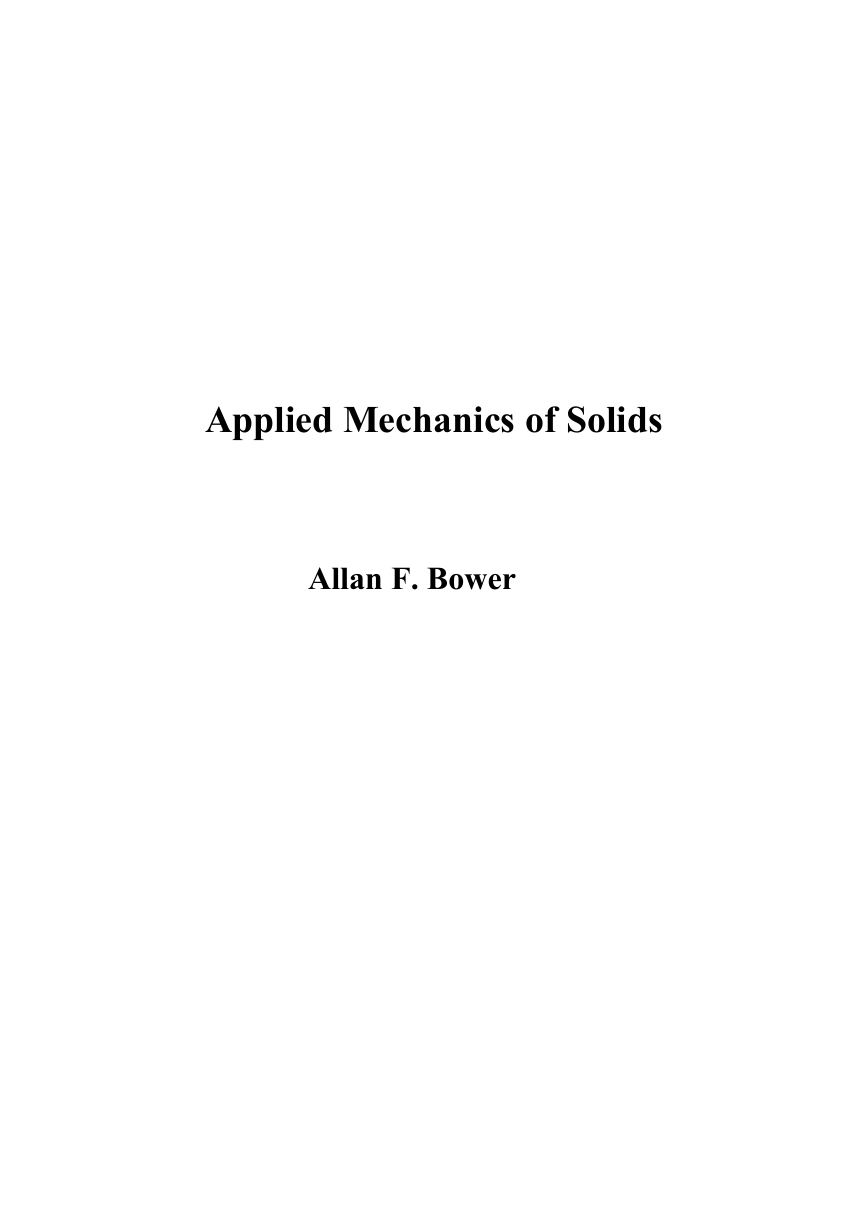
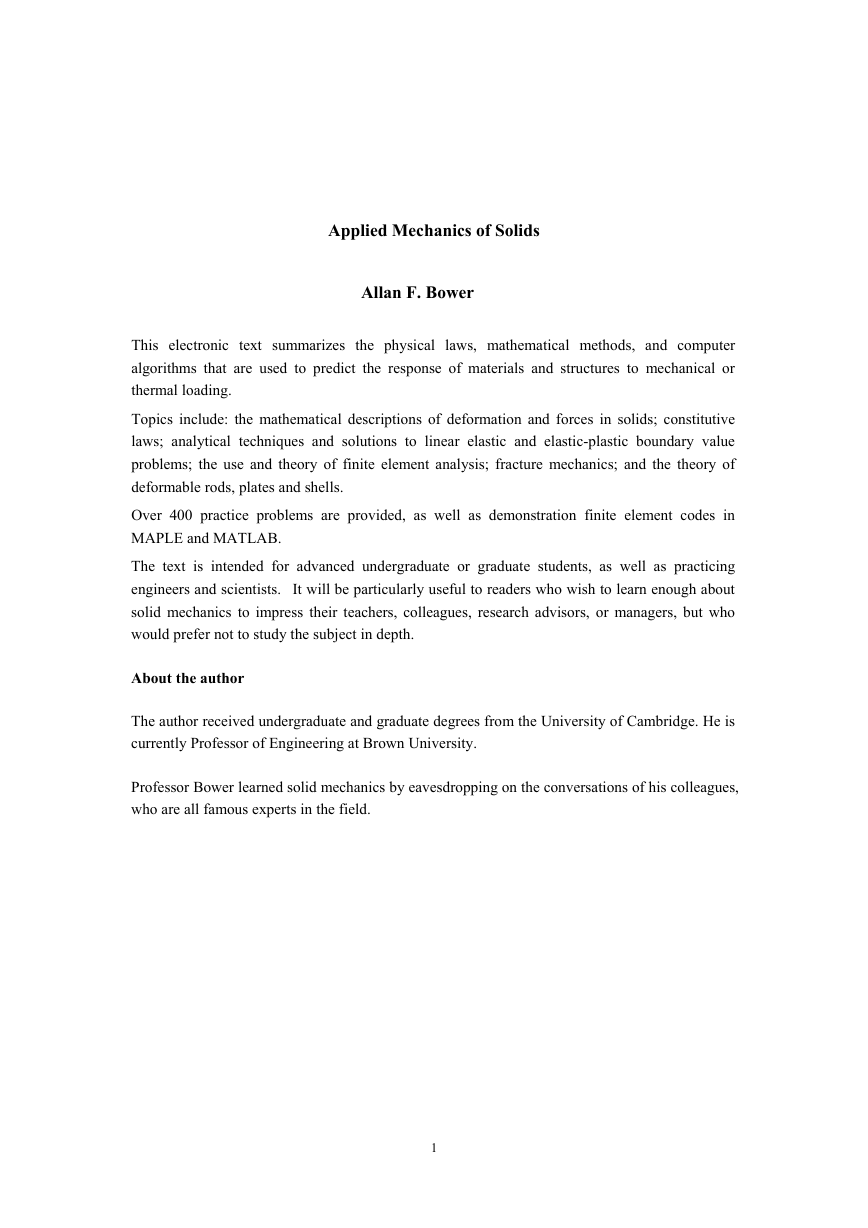
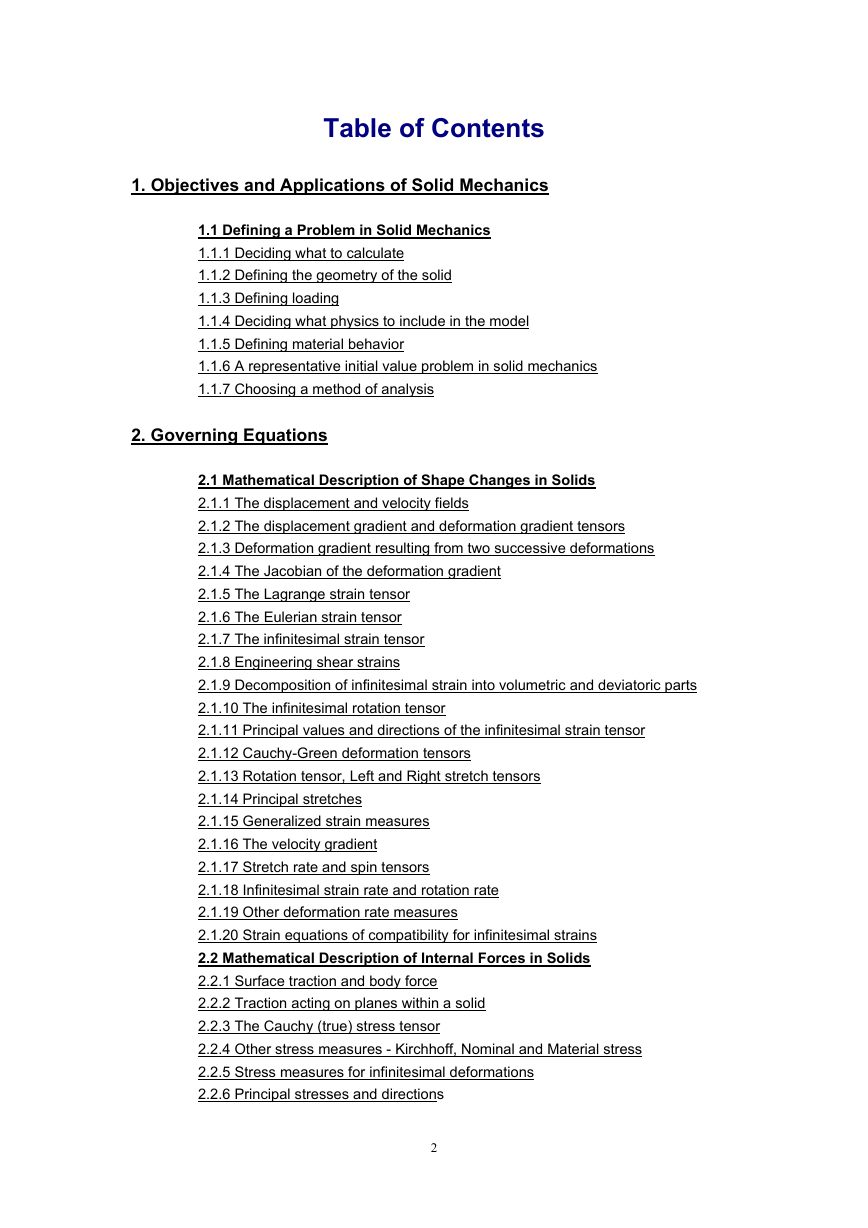
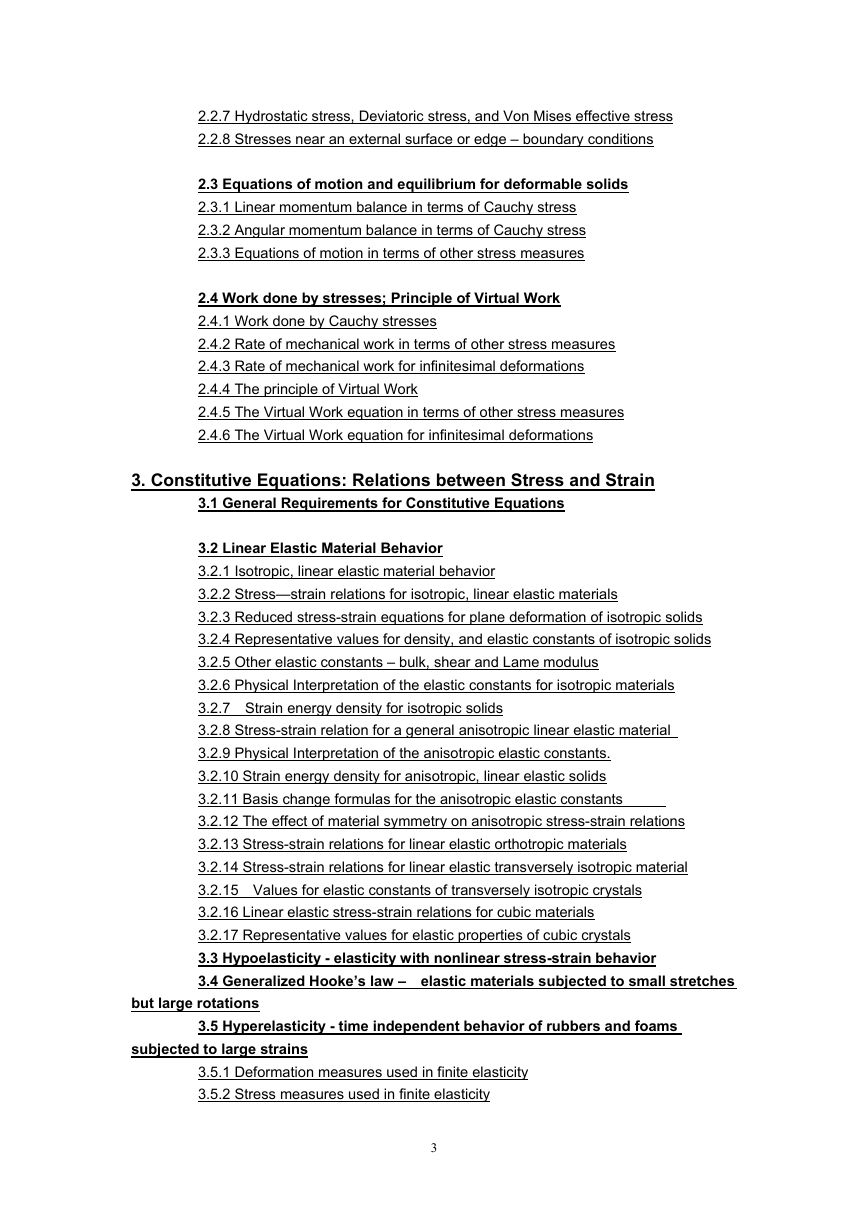
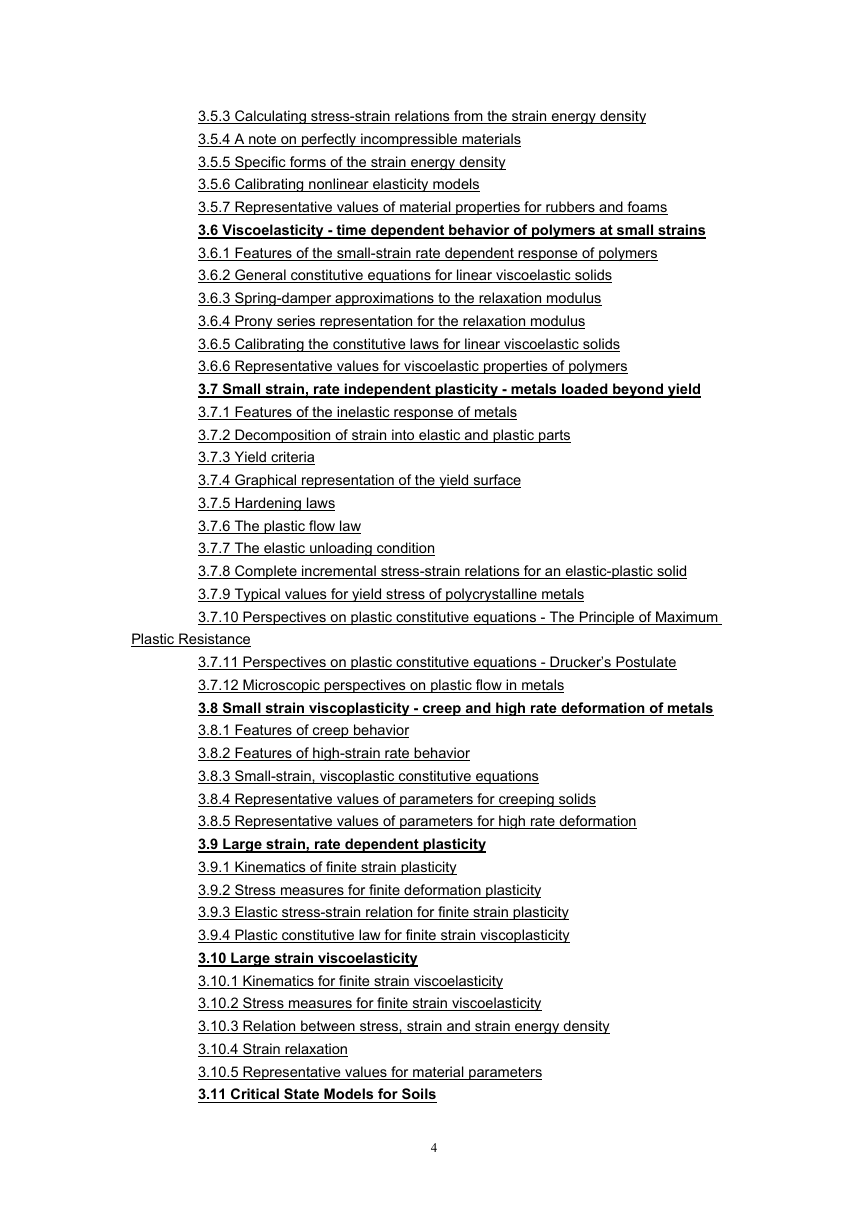
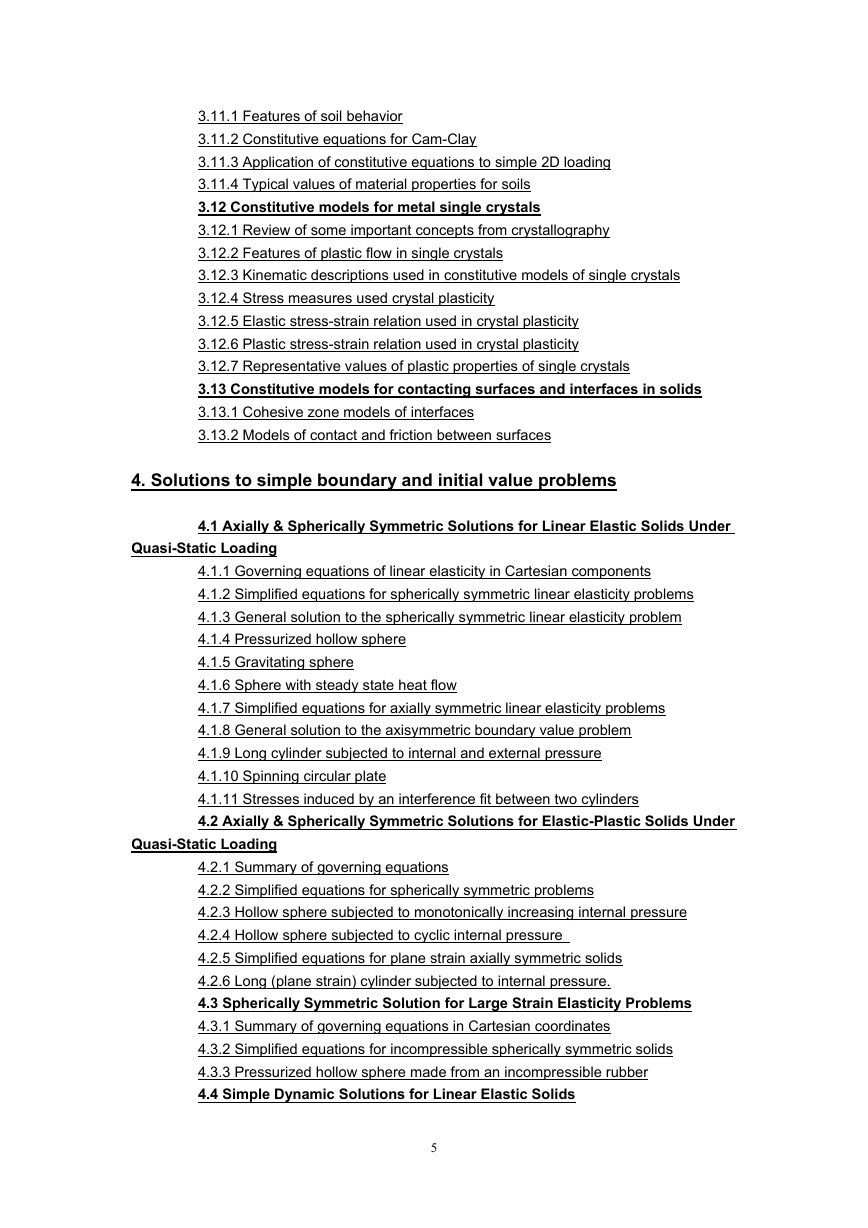
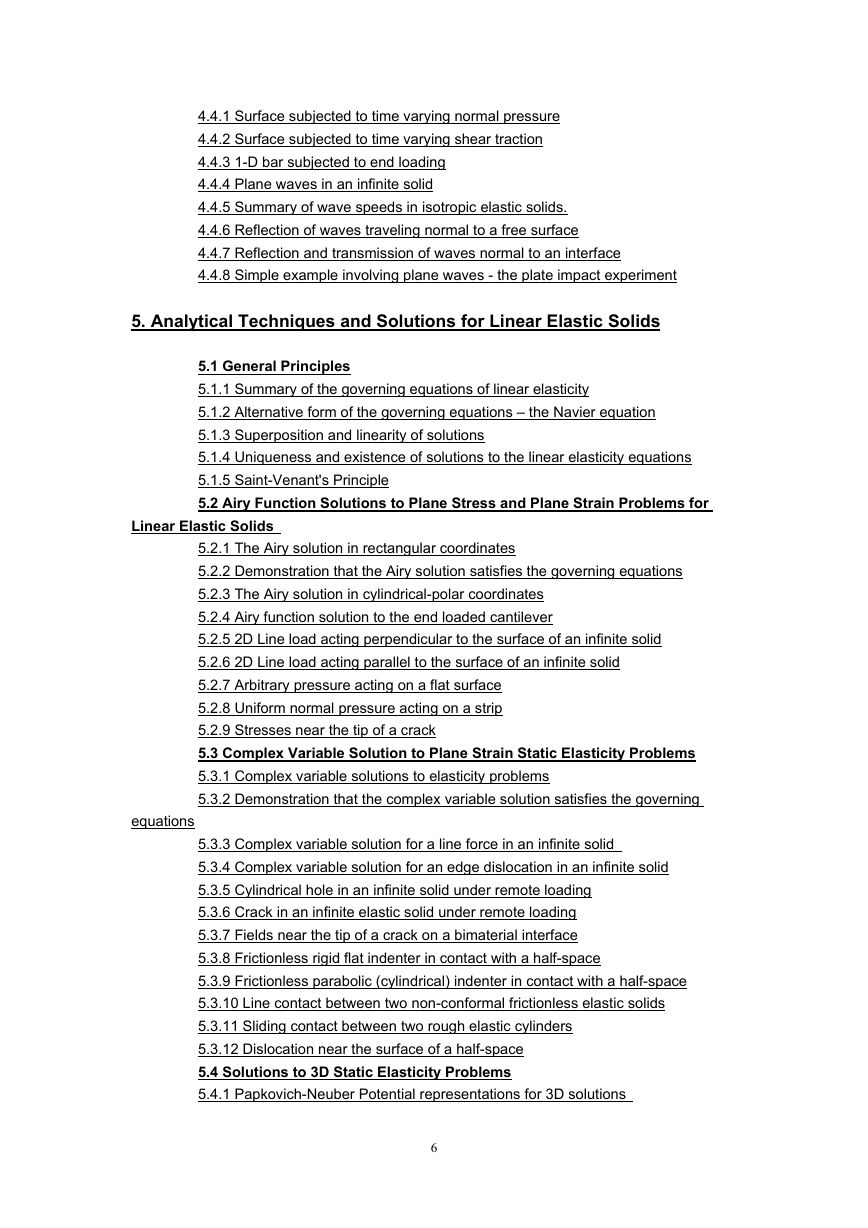
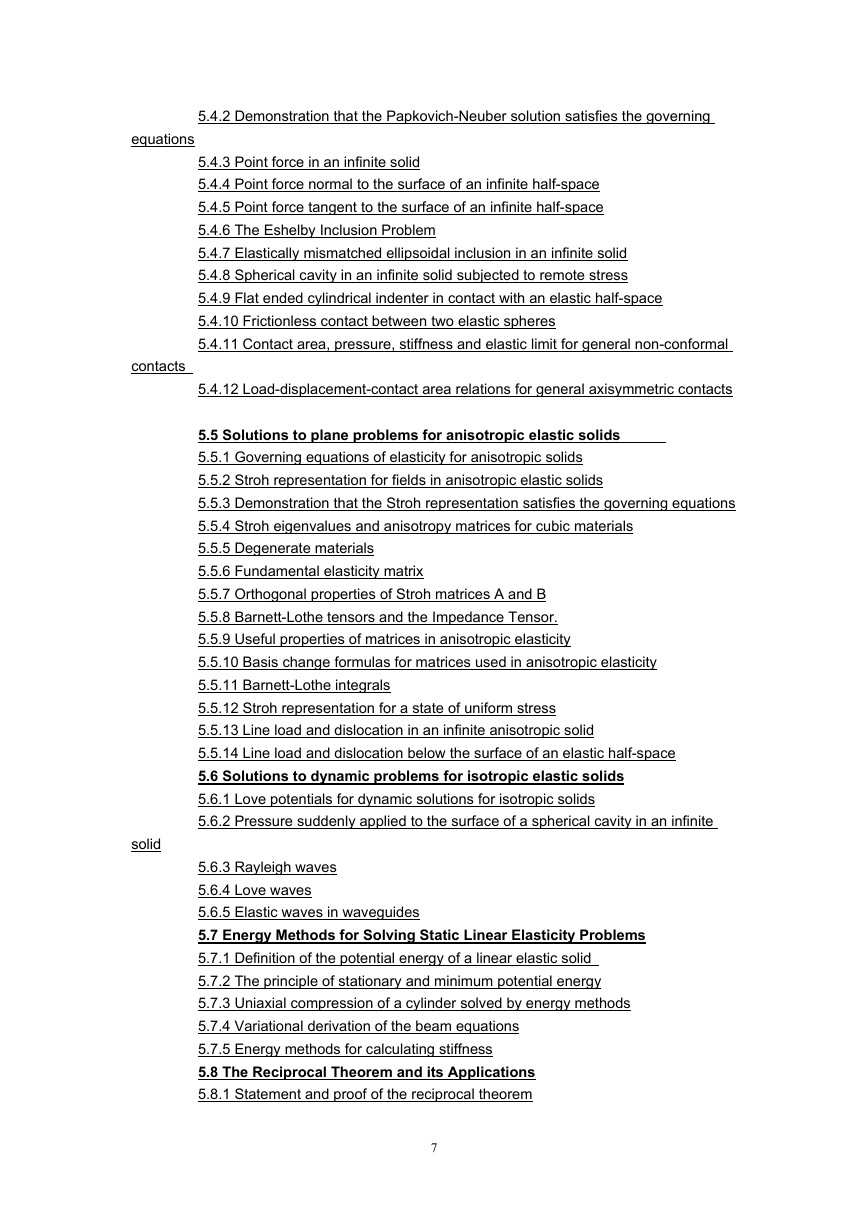








 2023年江西萍乡中考道德与法治真题及答案.doc
2023年江西萍乡中考道德与法治真题及答案.doc 2012年重庆南川中考生物真题及答案.doc
2012年重庆南川中考生物真题及答案.doc 2013年江西师范大学地理学综合及文艺理论基础考研真题.doc
2013年江西师范大学地理学综合及文艺理论基础考研真题.doc 2020年四川甘孜小升初语文真题及答案I卷.doc
2020年四川甘孜小升初语文真题及答案I卷.doc 2020年注册岩土工程师专业基础考试真题及答案.doc
2020年注册岩土工程师专业基础考试真题及答案.doc 2023-2024学年福建省厦门市九年级上学期数学月考试题及答案.doc
2023-2024学年福建省厦门市九年级上学期数学月考试题及答案.doc 2021-2022学年辽宁省沈阳市大东区九年级上学期语文期末试题及答案.doc
2021-2022学年辽宁省沈阳市大东区九年级上学期语文期末试题及答案.doc 2022-2023学年北京东城区初三第一学期物理期末试卷及答案.doc
2022-2023学年北京东城区初三第一学期物理期末试卷及答案.doc 2018上半年江西教师资格初中地理学科知识与教学能力真题及答案.doc
2018上半年江西教师资格初中地理学科知识与教学能力真题及答案.doc 2012年河北国家公务员申论考试真题及答案-省级.doc
2012年河北国家公务员申论考试真题及答案-省级.doc 2020-2021学年江苏省扬州市江都区邵樊片九年级上学期数学第一次质量检测试题及答案.doc
2020-2021学年江苏省扬州市江都区邵樊片九年级上学期数学第一次质量检测试题及答案.doc 2022下半年黑龙江教师资格证中学综合素质真题及答案.doc
2022下半年黑龙江教师资格证中学综合素质真题及答案.doc